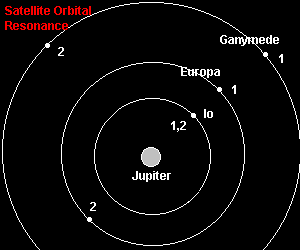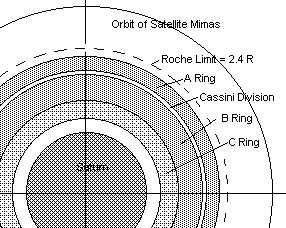 Galileo Orbitor:
Present Position of Orbiter
Io: Volcanic - molten interior heated by tidal action of Jupiter
Three Color Images of Io
Galileo Orbitor:
Present Position of Orbiter
Io: Volcanic - molten interior heated by tidal action of Jupiter
Three Color Images of Io
Due Wednesday November 25 Chapter 11 (Jupiter) Review Question #10 Problems #7 and #10 ALSO: Draw the Configuration of Jupiter's Satellites for November 25 at 6pm AST (Use the Configuration diagram in the Observers's Handbook or available on the Nov 16 lecture notes) Chapter 12 (Saturn) Review Questions #11, #15 Problem #7 Project #1 (you can use ECU)
Properties of Jupiter's Galilean Satellites:Eccentricity of Orbit = 0.004Galileo Orbitor: Present Position of Orbiter Io: Volcanic - molten interior heated by tidal action of Jupiter Three Color Images of Io
 Tidal Force from Jupiter ~ MJupiter/R3
Tidal Force from Jupiter ~ MJupiter/R3
MJ = 318 MEarth
distance about the same as Earth to Moon
so the tidal force on Io is 300 times that on the Moon
Libration due to excentricity yields planetary distortions
that heat the interior.
Eccentricity of orbit due to resonance with Europa and Ganymede
Resonance of Io, Europa and Ganymede Orbits
Plasma Torus Associated with IoAurora on Io due to particle bombardment Europa: Young Icy Surface - with possible ocean underneath Closeup of Europa's Surface Ganymede: Icy Satellite - lower density - Surface Distortions Plus Older Cratered areas Global View Details of Various Regions of Ganymede Callisto: Icy Satellite - Very Cratered Surface Asgard Impact Structure (Farther from Jupiter and not effected by tidal forces enough to allow melting and molding of the surface - older surface shows very old craters) Recent Magnetic Field Measurement Implies a Hidden Salty Ocean Comparison of the Four Galilean Moon Landscapes
Saturn
Physical Properties Orbit Distance = 9.54 AU Period = 29.42 years (Synodic Period = 1 year + 1/30 year = 1 year + 13 days) inclination 2.5o Eccentricity = 0.056 Planet Radius = 60265 and 54362 km 9.45 R(earth) (NOTE: Saturn's Volume is 60% of that of Jupiter yet its mass is 30% that of Jupiter and this is a result of lower compression of gas than on Jupiter. Jupiter's greater mass causes more compress and higher density.) Rotation Period = 10h 40m Axial Tilt = 26.7o (NOTE: Rings are edge on every half synodic period or about 15 years, last edge on was 1995-96 and next will be in 2011.) Oblateness = 1/10.2 --> means more gaseous than Jupiter which is 1/16 and hence a smaller relative size of its rocky core. Mass = 95.2 MEarth (Compare Jupiter at 318 MEarth) Density = 0.69 density of water g = 0.93 gEarth vesc = 35.5 km/s Radiation Balance: Albedo = 0.47 (47% reflectance of sunlight) Solar Flux = 1/(9.54)2 = 1/91 Solar Flux at Earth = 1340 W/m2 /91 = 15 W/m2 = 30% of the Solar Flux at JupiterT(eff) = 97 K compare T(solar equilibrium) = 75 K Radiation emitted/Radiation of Equilibrium (Stephan's Law) = (97/75)4 = 2.8 Saturn radiates almost 3 times as much as energy as it absorbs from the Sun BUT Saturn is smaller should cool faster, and have less gravitational energy. Saturn must have some other heat source than gravitational collapse. Magnetosphere: Magnetic Field Strength = 0.71 of Earths at Cloud tops B = Field Strength ~ Magnet Strength / R3 magnet(Saturn) ~ B * R3 = 0.71 x (9.5)3 = 600 m(earth) magnet(Jupiter) = 14 x (11.2)3 = 20,000 m(earth) Tilt of magnet = 0o Magnetosphere Size ~ 1.2 million km (16 RSaturn) Interior: (See Figure 12.7 Chaisson) T(core) > 15,000 K P > 5 Mbar T(metallic) > 8000 K P > 3 Mbar T(liquid H) > 250 K P >10 bar

Atmosphere: H2 97% He 1.5% (Less than on Jupiter or the Sun !!) CH4 0.1% (Methane) NH3 0.015% (Most Ammonia is frozen out of the atmosphere)Helium Rain 1. Explains the 2.8 times solar flux radiated by Saturn. 2. Explains the depletion of He relative to Hydrogen in Saturn's Atmosphere Helium rains down to lower levels in Saturn's interior and releases gravitiational energy and depletes He in the upper atmosphere. Cause: Saturn's upper layers are cold enough and high enough pressure to form liquid He which falls to the interior. Eventually this will stop and Saturn will cool to 75 K. High Winds West to East at equator = 1500 km/hr Atmospheric Layers are 3 times thicker than Jupiter's ~200 km thick compared with Jupiter's ~70 km Rings:

Thickness: 10's metres Particles ~ 0.1 mm to metres Icy Roche Radius: RRoche = 2.4 x Rplanet Radius inside which the tidal differential forces are greater than those of a fluid body held together by its self-gravitation. All Planetary Rings have R < RRoche Tidal force of Planet large enough to tear apart the satellite Life time of rings ~ 50 million years Synchronism: Mimas a = 186,000 km (3.1 RS) --> Cassini Division (2:1) Edge of A ring (3:2) Thin F ring R = 2.34 RS and sheparding satellites Prometheus 2.32 RS Pandora 2.37 RS Janus and Epemetheus and their Exchange Orbit ( in same radius) a = 151,000 km = 2.52 RS sizes 190 and 120 km At any one time one is in a slightly smaller orbit that the other and hence goes faster, catches up and is attracted to the other, moves out and switches orbits. Tethys, Calypso, and Telesto all in the same orbit but 60o apart Tethys is 1050 km while Calypso and Telesto are small (25 km) They are at the Lagrangian Points in Tethys' orbit Visitations: Pioneer 10 Dec 73 Flyby Pioneer 11 Dec 74 Flyby Voyager 1 Mar 79 Flyby Jupiter then Saturn 1980 Voyager 2 Jul 79 Flyby Jupiter then Saturn 1981 then Uranus and Neptune Galileo Dec 95 Orbiter and Probe into Jupiter Atmosphere Cassini Launched 1997 Rendevous Saturn 2004